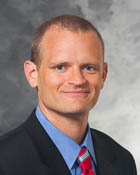
Michael Woods, M.D., fellow in Vascular and Interventional Radiology in the UW Department of Radiology, presented a faculty candidate lecture examining the benefits of early diagnosis of hepatocellular carcinoma (HCC), the most common form of liver cancer, and the 3rd largest contributor to cancer-caused deaths worldwide.
Woods reviewed the standards for diagnosing HCC, including the subtle differences in tumor size that account for differing classifications of the progression of the disease.
Once a diagnosis of HCC has been made, the treatment strategy is dictated by an algorithm that takes into account the progression of the cancer. “Surgical resection is the gold standard for non-cirrhotic patients, and improvement in surgical techniques has reduced the mortality rate to below 1%” said Woods.
For advanced-stage patients, intra-arterial and ablative therapies are among the only treatment choices available, according to Woods. While radiofrequency (RF) ablation has traditionally been the preferred ablative therapy, rapid advances in microwave ablation have resulted in it rapidly displacing RF ablation as the treatment of choice.
Woods went on to display several different cases of HCC at varying stages of the disease, illustrating the criteria for the differing diagnosis using imaging of the patients’ liver and abdominal cavity. He then took the audience through the stages of treatment for each patient, carefully noting the distinctive consequences of the various therapies as they appeared on liver imaging.
Woods used the example cases to stress the importance of early detection, as surgical resection and transplant consistently produced better patient outcomes than late-stage treatment options.